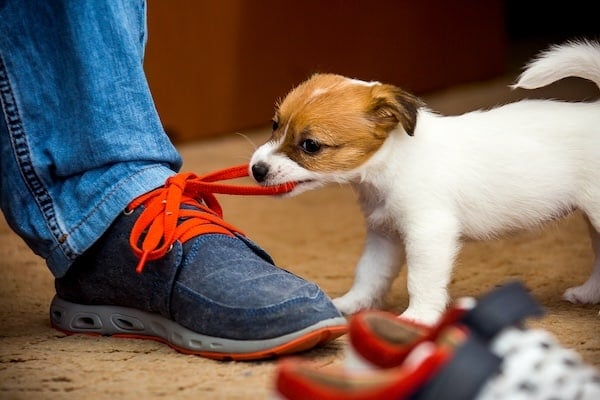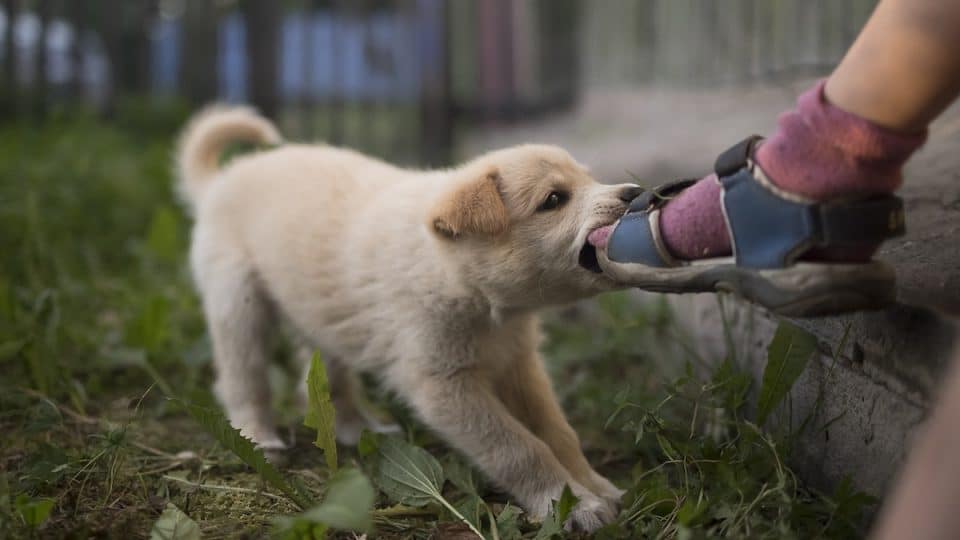- Not a substitute for professional veterinary help.
The term “ankle biter” didn’t always refer to dogs. It first appeared in Australia during the mid-1800s as a slang term for a young child. Over time, it came to mean something small and irritating. It wasn’t until the 1960s that “ankle biter” started being applied to small dogs, particularly aggressive ones, in the US.
The truth, however, is that “ankle biter” dogs can belong to just about any breed—and they can have very different reasons for the behavior that don’t have anything to do with aggression.
We spoke to certified dog trainers and veterinary technicians to learn why dogs do it, which breeds are more prone to ankle biting, and how to stop or redirect the behavior.
What Is an “Ankle Biter” Dog?
Ankle biting is a common biting behavior for puppies and adult dogs of certain popular breeds. Though the word “bite” easily conjures images of a violent attack, that’s not what we’re talking about here. In most cases, ankle biting is an instinctual or play-driven behavior.
Here are some examples of what ankle biting might look like.
- Your dog nips at your heels as you’re walking—without actually biting your foot—and stops when you stop moving.
- A dog runs circles around a group of playing children, occasionally closing in to nip at a fleeing foot before darting away again.
- Your new puppy tugs at your socks or pant leg when you decide to end a play session and get up to walk away.
- A stray dog (or one otherwise unfamiliar to you) takes quick steps toward your legs, maybe snapping their jaws or nipping at your shoes.
Why Do Dogs Bite Ankles?
A dog’s motivations for biting at ankles varies depending on both the dog and the situation. Allie Bender, a certified professional dog trainer and founder of Pet Harmony Animal Behavior & Training, explains that while most people think of it as a herding behavior, it can also be a product of fear, anxiety, play, or attention-seeking.
Breed-specific herding instincts
Many dogs who exhibit ankle biting behavior don’t just nip at ankles. They may also chase children or small pets, using their movements to urge them in a particular direction. In other words, they’re acting out their herding instincts.
“When we see this behavior in relation to herding,” says Bender, “we typically see [the dog] start biting ankles/feet when someone moves and then stop when the human stops.” Anyone walking, running, or playing vigorously might trigger a dog’s herding instincts.
Play behavior driven by excitement
Nipping and biting is a natural aspect of play for many dogs. Puppies are especially prone to biting because it’s one of the first ways they learn to interact with their littermates.
In adult dogs, non-aggressive biting can be a product of excitement. If your dog bites your ankles when you walk away from a play session, they may simply think it’s part of the game.
Attention-seeking behavior
If your dog tends to nip at you, seemingly unprompted, it may just be their way of getting your attention. Nothing says “Pay attention to me!” like the pinch of a sharp tooth (or a mouthful of them). It’s easy to reinforce this kind of behavior by accident—even if your only response is to look at your dog when they do it.
Response to fear or pain
When a dog who doesn’t usually play rough or nip at your ankles suddenly starts to, don’t ignore it. Aggression is a go-to defense for dogs when they’re feeling anxious or fearful and want others to keep their distance. It can also be a self-protective response to pain.
If your dog is exhibiting uncharacteristic aggression, it’s wise to consult your veterinarian to rule out underlying medical causes.

GlobalP via iStock
Ankle Biting Breeds
Ankle-biting is a natural canine instinct and not necessarily breed-specific. But there are some breeds that are especially prone to nip at human heels.
Herding dogs like Australian Cattle Dogs (Heelers), Border Collies, and even small dogs like Corgis are well-known ankle biters. Other dog breeds that may bite ankles due to their herding instincts include:
For some toy and small breeds, the heels and ankles are as high as they can reach. Whether they’re looking for attention, expressing frustration, or acting out of fear or anxiety, the following breeds can become ankle biters largely due to their small size:
- Boston Terrier
- Chihuahua
- Dachshunds
- French Bulldog
- Maltese
- Pomeranian
- Shih Tzu
- Toy Poodle
- West Highland White Terrier
- Yorkshire Terrier
There are also versatile breeds that have been bred and trained for a variety of uses throughout history. Some Boxers may have herding instincts, for example, and German Shepherds have strong protective instincts that manifest as ankle biting.
How To Manage Ankle Biting
When it comes to managing undesirable dog behaviors, your behavior matters just as much as your dog’s. Christy Caplan, a certified veterinary technician, says, “The more people react to the behavior by running and yelling, the more likely your dog thinks this is a game.”
Here’s what to do in the short-term to manage ankle biting—and what not to do.
Things to avoid
- Avoid reinforcing ankle biting behavior by giving your dog attention or yelling.
- Don’t punish your dog. You might accidentally reinforce the behavior or, if it’s motivated by anxiety or fear, make matters worse.
- Once you know your dog’s triggers, avoid them while you work on training.
Things to do
- When ankle biting happens, ignore it and calmly remove yourself from the situation, or redirect your dog.
- Pay attention to your dog’s body language so you can step in before ankle biting starts.
- Manage situations where your dog is likely to bite ankles by keeping them calm or otherwise occupied.
- Increase exercise and enrichment to prevent boredom or frustration that might manifest as ankle biting. Caplan recommends a daily enrichment schedule of toys, food enrichment like treat dispensers, and environmental enrichment like decompression walks.
- Though typical ankle biting rarely breaks the skin, learn how to treat a dog bite, just in case.

Oksana Kuznetsova via iStock
How To Stop Ankle Biting with Training
Long-term training is the best solution to stop ankle-biting. Here’s a quick step-by-step guide to get started, with motivation-specific tips below.
- Observe your dog and take note of the situations in which they exhibit ankle biting behavior, plus the triggers that precede it.
- Try to determine the underlying motivation for the behavior. In other words, figure out what your dog is trying to achieve through ankle biting.
- Consider your usual response to your dog’s ankle biting. If you’ve been reinforcing it by giving your dog what they want, stop doing it.
- Start redirecting your dog toward a more appropriate outlet when they nip at ankles. For example, offer them an interactive toy to relieve boredom or pent-up energy.
- Find ways to meet your dog’s needs so they stop feeling the need to nip. For example, give herding dogs opportunities for active enrichment like chasing a ball outside.
How To Stop Different Types of Ankle Biting
Because dogs have such different reasons for ankle biting, it’s important to tailor your training to your individual dog and their needs.
Herding tendencies
If your dog exhibits herding tendencies, Bender recommends leaning into it. Don’t just redirect your dog’s energy with a toy or treat. Instead, give them a safe outlet and develop the behavior in a healthy way.
If you live in a rural area, for example, see if you can give your dog some practice herding sheep. Or try an urban herding sport like treibball.
High-energy dogs
If you have a high-energy dog who nips at your ankles out of boredom, find creative ways to work off excess energy and provide mental stimulation. Dog sports work well in this case, too. Try agility for an Australian Shepherd who loves to run or dock diving for a Beagle who loves to chase down toys.
Territorial dogs
Some dogs nip ankles as a warning when they’re feeling territorial or resource guarding. These pups benefit from desensitization and positive reinforcement.
For dogs who guard objects or food, work slowly by offering high-value trades. For territorial pups, consider enlisting the help of dog-savvy friends and family to practice approaching slowly, using lots of snacks and carefully watching body language.
If you’re feeling uncertain, a dog training professional or canine behaviorist can be a big help with guarding behavior.
Attention seekers
Dog breeds that need a lot of attention like Yorkshire Terriers and Chihuahuas may benefit from scheduled play sessions or additional training as a bonding exercise. When your dog’s needs are met, they may be less likely to nip as an attention-seeking behavior.
Small attention-seekers in particular can benefit from an approach that takes into account small dog syndrome and uses gentle, rewards-based training.
Puppies
If your little nipper is still young, you may be able to curb the behavior before it becomes fully ingrained. Redirection is the most effective method to stop a puppy from biting, whether the target is your ankles, hands, or other objects.
Caplan recommends keeping your puppy’s favorite toy in your pocket at all times. When you’re playing or taking a walk and your puppy starts to nip, stop what you’re doing immediately. Give your puppy a moment to note the change, then offer them the toy to chew on instead.
Biting Other Dogs’ Ankles
An ankle biter dog may nip primarily at people, but the behavior can also come out in interactions with other dogs. “Typically we see dogs biting the ankles of another dog in play,” Bender says. “Or sometimes as a sort of attention-seeking behavior, but not as frequently.”
But how do you know when ankle biting is nothing to worry about and when it’s a problem? It depends on the dog(s) involved and the situation.
When it’s an element of healthy, consensual play between dogs, ankle biting is generally not a problem. “However, there are some dogs,” Bender says, “who are not okay with this at all or have a problem if the biting becomes too hard.” If the other dog doesn’t like it or if there’s a risk for injury, it may be necessary to step in.



